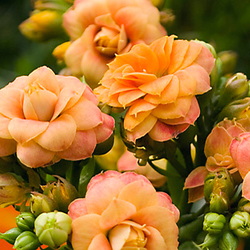Kalanchoe is winter hardy in USDA Zones 10 to 12. In those frost-free zones, it is grown outside where it prefers sandy, well-drained sun in full sun or bright indirect light. In other parts of the country the plants are usually grown in containers so that they can be protected from freezing temperatures. Kalanchoe is moderately salt tolerant, so it is an ideal plant to grow on sunny decks that are near bodies of salt water.
After flowering, the stems stretch and seem to lose some of their sturdiness. Some people throw them away when this happens. However, if they are cut back after they bloom and fed with a water soluble liquid fertilizer on a regular schedule, they will grow new, sturdy branches. If they are grown outside during the summer where they can get a minimum of four hours of sunlight a day and protected from freezing weather the following winter, they will grow again into sturdy plants and produce a bountiful crop of flowers the following spring.
Propagation
After a while, however, you might wish start a new plant. Stems root easily when stuck in moist, well-drained soil. Some experts recommend letting the cuttings harden for several days before placing them in the potting mix. This might prevent rot if the potting soil is too wet, but my cuttings have always rooted well when I cut them and placed them immediately in soil.
Forcing Bloom
 Kalanchoe can be forced to bloom at Christmas time (or at any time, for that matter). This can be done because kalanchoe is photoperiodic, which means that it reacts in a certain way to the daily cycle of light and darkness. Buds are initiated in response to fewer hours of light, or more hours of darkness. If you have a kalanchoe left over from last year and want it to bloom for Christmas, provide it an extended period of darkness for 30 days beginning about the first of September. Simply cover the plant with a black cloth from 6 PM to 7AM each night until October 1. Then uncover it and watch the flower buds develop. It will bloom for you during the holiday season.
Kalanchoe can be forced to bloom at Christmas time (or at any time, for that matter). This can be done because kalanchoe is photoperiodic, which means that it reacts in a certain way to the daily cycle of light and darkness. Buds are initiated in response to fewer hours of light, or more hours of darkness. If you have a kalanchoe left over from last year and want it to bloom for Christmas, provide it an extended period of darkness for 30 days beginning about the first of September. Simply cover the plant with a black cloth from 6 PM to 7AM each night until October 1. Then uncover it and watch the flower buds develop. It will bloom for you during the holiday season.
Keep this in mind if you purchased a kalanchoe for this Christmas. Next Christmas it will strut its stuff all over again if it is provided with ample hours of darkness next fall. If all this seems like too much trouble, don't worry about it. Kalanchoe will bloom in spring under normal houseplant growing conditions. 
Pronouncing the Name
How do you say Kalanchoe? I asked that question at a recent lecture and was not surprised when several different pronunciations were suggested. Most said kuh-LAN-choe. One person said kuh-LAN-ko-ee. Still others insisted that the word was kal-en-KOH-ee. Who was right? In the final analysis, all were probably correct. Most authorities, however, have agreed on the third pronunciation, so that is the one I choose. So be sure that while you're reading this article that you read "kal-en-KOH-ee," because that's what I'm saying. You couldn't have known that if I hadn't told you.
Tony Avent once said, "Interestingly, the most discussed part of nomenclature is pronunciation. No one seems concerned if the naming rules are followed, but it drives people nuts if you pronounce it wrong. Geez, folks, Latin is a dead language. Let's worry about getting the names right, and as long as you can communicate, pick something more important to fight about." I concur with Tony's statement. Why argue about how to say Kalanchoe, or potato or tomato.
Kalanchoe blosfeldiana has some interesting cousins. Geoff Stein gives a thorough introduction to the genus in his article. Like most other groups of plants, this one has some desirable members and some less desirable. Choose carefully for your garden, or you will, like Geoff, be forever pulling out the thousands that K. diagremontiana mothered.
















